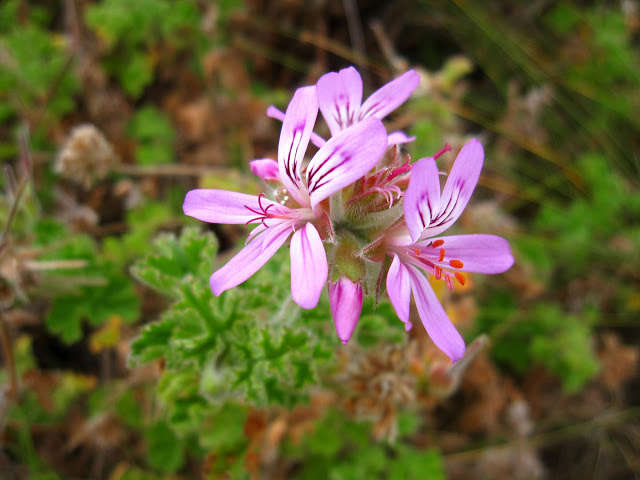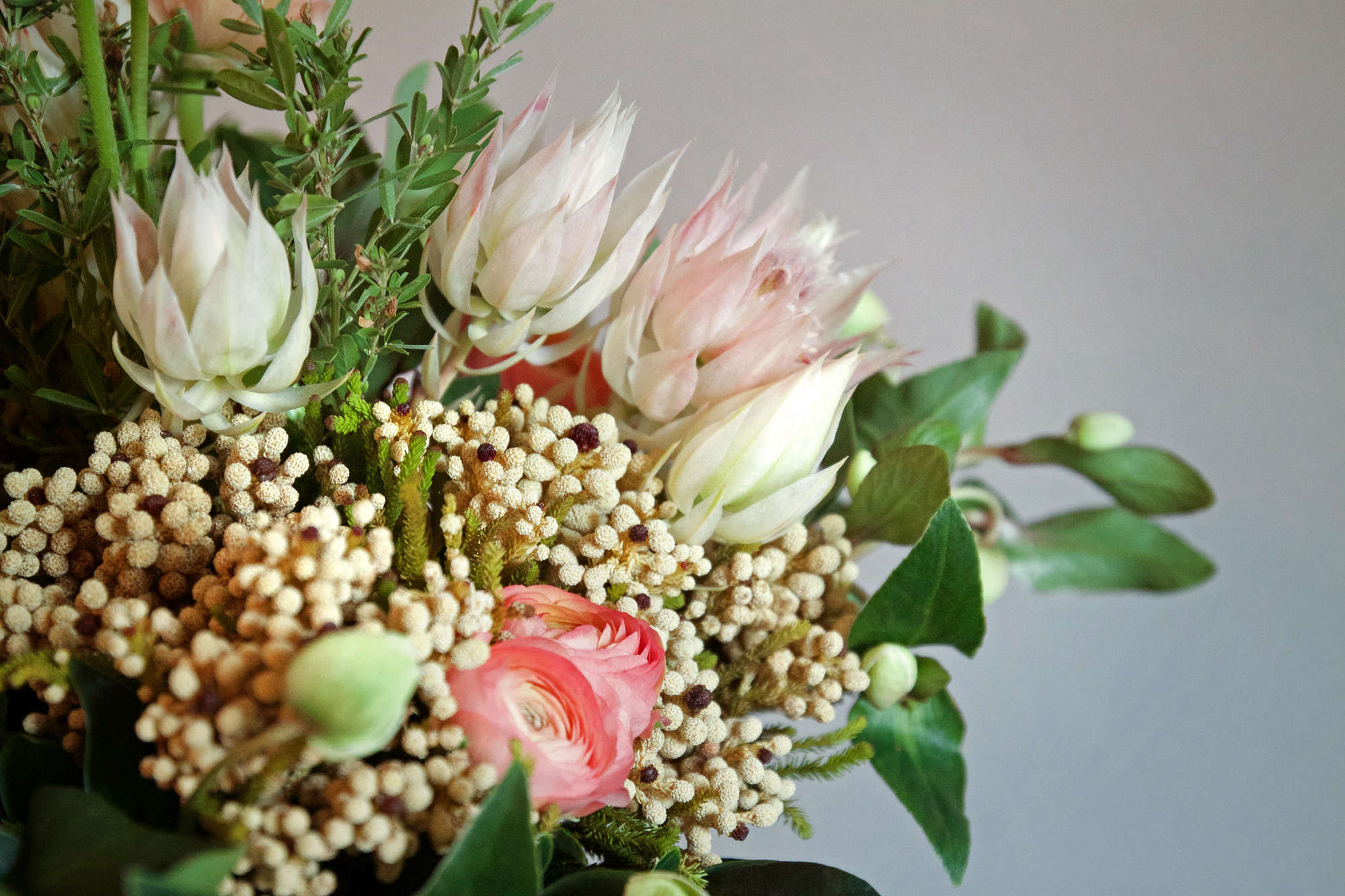For as long as humans have grown flowers for pleasure they have been drawn to the exotic and the unusual. As a gardener I support the indigenous gardening movement for environmental reasons, but I am not a fundamentalist (I would hate to lose my Asian lilies and roses). As long as exotic plants are not regionally invasive, they can be beautiful additions to our growing lives. South Africa has an intensely rich botanical heritage, and many of the ornamental plants that grace international gardens have South African roots. Here is a collection of stunners that can be grown as annuals or perennials (depending on your climate) in the US:
Photography by Marie Viljoen.
Protea
Above: For information on how to purchase proteas, see California Protea Society.
On a flower hike on Table Mountain, proteas proliferate, from the imposing king protea to species of Leucaspermum (pincushions) that look like intricate wirework. For foreign visitors who have only seen these prehistoric-looking blooms as cut flowers, walking here is a thrill. Protea plants are becoming available stateside and can be grown where winters are moist and summers dry (hello, California!). Sustained freezes will kill the plants. The woody shrubs prefer lean, slightly acidic soil. Do not fertilize them and do not grow them in bed with other plants that require feeding. Full sun and superb drainage are essential. The cut blooms will last for weeks in water.
Agapanthus
Above: For a variety of Agapanthus rhizomes ($18 apiece), see Plant Delights.
Another beauty from the mountains of the Western Cape is the gorgeous agapanthus (also called Nile lily). Cultivars come in the full range of blues, from baby to violet to near-black, as well as in blue-and-white combinations. Their tall stems look wonderful massed in a border or used as accent plants in small gardens. They work well in pots. Some sources cite USDA Zone 6 as the lower limit of their range but I am skeptical and suggest Zone 8 (with plenty of mulch to cover them in winter); their rhizomes do not appreciate real freezing. If in pots in colder areas move them into a cold cellar or garage in fall.
Clivia
Above: Grown in prolific sweeps in their South African homeland, clivias are better known as houseplants in many parts of the States. I know of two plants that are 16 years and older (mother and child) in a south-facing but shaded Brooklyn parlor window where they bloom up to three times a year. This is one plant that likes to be squeezed and rootbound, but it hates wet feet. Dry is better. Use a slow-release fertilizer when potting them, and keep the plants in indirect but bright light. Provoke a period of dormancy by moving the pots to a cool room for eight weeks in late fall; do not water then unless you notice the leaves wilting. Move them back after their rest and begin weekly watering, for spring flowering. In-ground, plant clivias in USDA Zones 9 and higher, in dappled shade.
Plectranthus
Above: Plectranthus are a spectacular alternative to the usual suspects (mums mums mums) when you want flowers in autumn. ‘Mona Lavender’ is the best known—bred at Kirstenbosch National Botanic Garden in Cape, and plants are now available as annuals to plant in summer and to mature around late September, blooming through October in chilly climates. The flower spikes are striking when massed and last well as cut flowers, too. In USDA Zones 10 and higher plectranthus can be grown as perennials with species ranging from ground covers to shrubs. Plectranthus root very easily from cuttings.
Crocosmia
Above: A variety of crocosmia corms (colors range from orange to yellow) is available ($3.95 for five bulbs) from Blooming Bulbs.
Patches of electric crocosmia light up moist stream banks in its South African habitats. Now a well-established ornamental in European and American gardens, the corms are often sold in nurseries and big box stores, and are available online. The tall sword-shaped leaves appear in early summer but the flower-show only begins in late summer and can last through early fall, just in time for migrating hummingbirds to find them. ‘Lucifer’ is one of the hardiest cultivars, with some gardener-reports saying that it can survive up to Zone 4, though Zone 5 is safer.
Nemesia
Above: A 4-inch pot of Nemesia cheiranthus is $4.95 from Annie’s Annuals.
If you are lucky enough to visit South Africa in late August or September, you can see fields of nemesias in bloom in Namaqualand in their native spring. The pretty little annuals are now a regular nursery favorite when pansies appear. I love them as annual companions for violas. They like the cold nights of early spring and will become leggy as the weather warms. Cut them back after flowering and you may have a second flush. As cut flowers they are very sweet in miniature bouquets with other tiny spring flowers like violets. Excellent in small pots on balconies and terraces, they need at least four hours of direct sun and can cope with more.
Bulbinella
Above: Bulbinella plants are like little first aid kits. The sticky sap from their succulent leaves is traditionally used (and its efficacy has been proven) to treat burns, superficial cuts, cold sores, and cracked lips. Plus it has very appealing flowers which last well in water. Bulbinella is a drought tolerant plant and can be grown as a perennial in Zones 9-11 or as an annual in colder climates. It survives indoor life as long as it is kept in sunlight (for blooms) or very bright light, and enjoys excellent drainage.
Pelargonium
Above: A 3-inch pot of rose scented pelargonium is $4.65 from Colonial Creek Farm.
No mention of South African plants would be complete without pelargoniums. Because every fat red window box geranium you see is really a pelargonium. And while these hybrids and cultivars are appealing in a very retro front-doorstep kind of way, I love the scented pelargoniums which can often be found in the herb section of local nurseries. Back to those Cape Town hikes—walking along and bending to crush the soft leaves of what is locally called kusmalva, is a rose-scented tonic on a hot day under an uncompromising African sun. Rose scented pelargonium leaves laid at the bottom of cake pan scent the batter, and handful of crushed, velvety peppermint pelargonium (my favorite) tossed into a hot bath at the end of a long day is a restorative pick-me-up.




















Have a Question or Comment About This Post?
Join the conversation